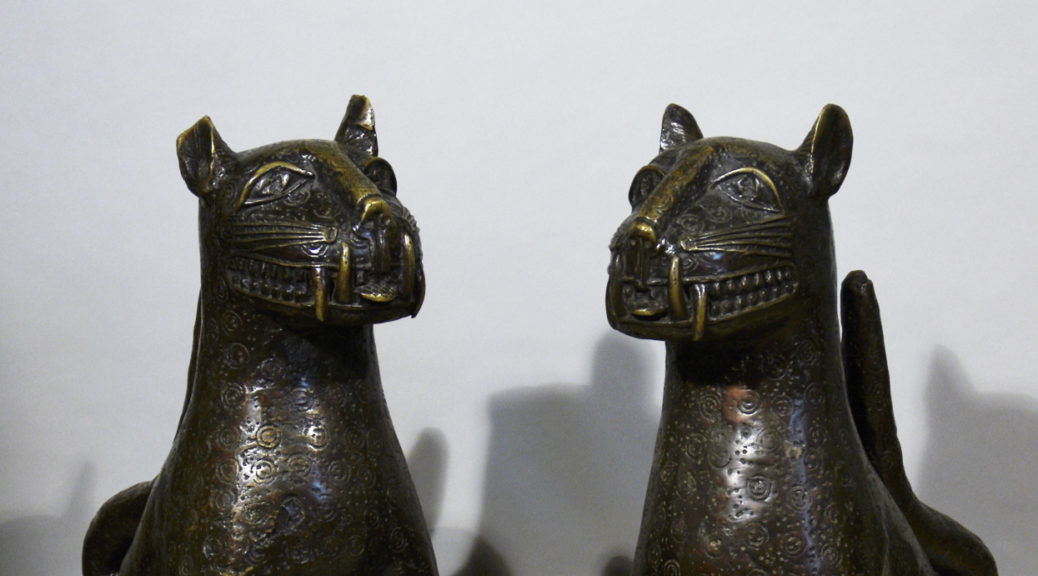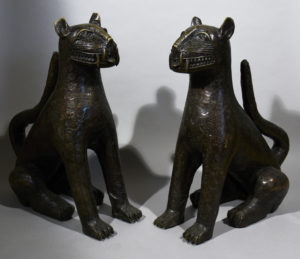LCK 0604-20
Pair of Benin Bronze Royal Leopard, Nigeria
These two exceptionally beautiful seated male leopards have probably been placed as guards at the Royal Palace as an emphasis on both its own exalted positions and responsibilities.
In African culture the leopard is traditionally known as the Great Watcher, and is a symbol for cunning, agility, and ferocity. The leopard is highly revered in African cultures as a master hunter due to its secrecy and mystery.
Among bronze animal depictions in Benin art the leopard appears most frequently. As “king of the forest” his reputation is as great as that of the Oba, or king. Killing a leopard was a privilege of the Oba, who had his own association of leopard hunters equipped with “special powers” which enabled them to kill these animals without losing their own lives.
Brass has a long tradition in West Africa, being used from Mali to the coast of Guinea and from Liberia to the Lower Congo, and more than 1,000 years ago it began to be used extensively to produce “court art.”
Brass casters held a unique position among the artisans of Benin. They were a royal guild and a sort of title of nobility was granted to artisans who distinguished themselves through their work. Nevertheless, pieces were often collaborative and even today there is no way to determine whether a master pieces like these two outstanding artistry leopards were the creation of a single master or several workers.
How these two majestic guardians ended up in Europe, there is a theory that they may originate from the terrible incident that overcame Benin in 1897.
What we know is that when the Portuguese first set foot on Benin at the end of the 15th century, Benin was a city-state in the middle of the rainforest that surpassed many late medieval European cities in urban development and where the streets were lit at night by palm oil lanterns.
“The king’s court is as large as the city of Haarlem, and divided into many magnificent palaces, houses and rooms of the courtiers, and galleries, about as large as “The Exchange at Amsterdam,” the Dutch geographer Olfert Dapper wrote in 1668 about the Oba’s court, based on accounts of explorers and missionaries who had visited Benin.
All this was destroyed and burned down when the British on January 4, 1897 sent a military operation with 1.200 Royal Marines and 250 African soldiers against Benin to depose the king through force, known as the British Punitive Expedition. The field commanders were instructed by their commander-in–chief to burn down all Benin kingdom’s towns and villages, to cleanse them of the blood and gore, and they were also instructed to hang the king of Benin wherever and whenever he was captured. The Oba was deposed and the accumulated works of art from many centuries which adorned the palace were all removed. Over 4,000 royal artworks were taken by the British, and then sold by the British Government to help recover the cost of the expedition. And about 40% is still kept in the British Museum. However, the soldiers instead of being paid salaries were allowed to take as war booty an unknown number of objects which they sold at the harbor and in harbor pubs around Portsmouth.
Age: 17th Century AD.
Measure: Male 1. H: 66, W: 31, D: 59 cm – Weight: 34,100 kilos
Male 2: H: 66, W: 29, D: 61 cm – Weight: 36,400 kilos
Condition: Despite age and diligent use, these two male leopards are in exceptionally good condition. They stand / sit with a rarely seen radiant beautiful dark brown bronx glow without any damage or shards.
Provenance: What we are told these two leopards were bought on a Dutch auction in early 20th century and brought to Nirobi, Kenya. Probably by diplomats and sold to a chain of local art dealers from where we bought them in 2004.
These two Royal Guard Leopards could have been among the effects from the “Bloody Massacre” in 1897.
Literature – books:
“The Kingdom of Benin in West Africa” by Heather Millar. Reviewed by Dan Ben-Amos.
“Benin Kingdom of West Africa” by John Peffer-Engels
“The Bini People of the Benin Kingdom” by Chukwuma Azuonye. Reviewed by Joseph Nevadomsky
“Höfische Elfenbeinschnitzerei im Reich Benin”: Kontinuität oder Kontinuitätspostulät by Stefan – Eisenhofer. Reviewed by Barbara W. Blackmun
“Lamidi Olonade Fakeye”: A Retrospective Exhibition and Autobiography by Lamidi Olonade Fakeye – and Bruce M. Haight. Reviewed by Jean M. Borgatti.
Request price for Bronze Leopards



